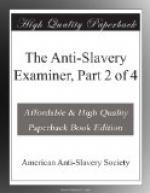BREAKFAST AT MR. THORNE’S.
By invitation we took breakfast with Mr. Joseph Thorne, whom we met at Mr. Harris’s. Mr. T. resides in Bridgetown. In the parlor, we met two colored gentlemen—the Rev. Mr. Hamilton, a local Wesleyan preacher, and Mr. Cummins, a merchant of Bridgetown, mentioned in a previous chapter. We were struck with the scientific appearance of Mr. Thorne’s parlor. On one side was a large library of religious, historical and literary works, the selection of which displayed no small taste and judgment. On the opposite side of the room was a fine cabinet of minerals and shells. In one corner stood a number of curious relics of the aboriginal Caribs, such as bows and arrows, etc., together with interesting fossil remains. On the tops of the book-cases and mineral stand, were birds of rare species, procured from the South American Continent. The centre table was ornamented with shells, specimens of petrifactions, and elegantly bound books. The remainder of the furniture of the room was costly and elegant. Before breakfast two of Mr. Thorne’s children, little boys of six and four, stepped in to salute the company. They were of a bright yellow, with slightly curled hair. When they had shaken hands with each of the company, they withdrew from the parlor and were seen no more. Their manners and demeanor indicated the teachings of an admirable mother, and we were not a little curious to see the lady of whose taste and delicate sense of propriety we had witnessed so attractive a specimen in her children. At the breakfast table we were introduced to Mrs. Thorne, and we soon discovered from her dignified air, from the chaste and elevated style of her conversation, from her intelligence, modesty and refinement, that we were in the presence of a highly accomplished lady. The conversation was chiefly on subjects connected with our mission. All spoke with great gratitude of the downfall of slavery. It was not the slaves alone that were interested in that event. Political oppression, prejudice, and licentiousness had combined greatly to degrade the colored community, but these evils were now gradually lessening, and would soon wholly disappear after the final extinction of slavery—the parent of them all.
Several facts were stated to show the great rise in the value of real estate since 1834. In one instance a gentleman bought a sugar estate for nineteen thousand pounds sterling, and the very next year, after taking off a crop from which he realized a profit of three thousand pounds sterling, he sold the estate for thirty thousand pounds sterling. It has frequently happened within two years that persons wishing to purchase estates would inquire the price of particular properties, and would hesitate to give what was demanded. Probably soon after they would return to close the bargain, and find that the price was increased by several hundreds of pounds; they would go away again, reluctant to purchase, and return a third time, when they would find the price again raised, and would finally be glad to buy at almost any price. It was very difficult to purchase sugar estates now, whereas previous to the abolition of slavery, they were, like the slaves, a drug in the market.




